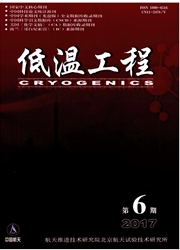

 中文摘要:
中文摘要:
针对SPICA太空望远镜采用的两级斯特林制冷机预冷J—T循环获得4K级冷量而建立了Sage模型,并用文献中的实验数据验证,基于此模型分析高压压力P_H与末级预冷温度Tpre[2]对系统性能的影响。从耗功的角度来看,降低Tpre[2]和适当升高PH有利于增大J—T级的制冷量,但Tpre[2]的降低使预冷斯特林制冷机耗功增大;而P_H的增高不仅使J-T压缩机耗功增大,而且实现困难,制冷系统的优化要选择合适的Tpre[2]和P_H以使总耗功最小。此外,对循环进行了炯分析。
 英文摘要:
英文摘要:
A sage model was set based on the Joule-Thomson cycle, which was utilized to precool SPI- CA space telescope by two-stage Stirling cooler to obtain cooling capacity in 4K stage. The Sage model was verified by experiment data. It was analyzed that high pressure P. and precooling temperature in the last stage Tpro[2] affects system performance. In the view of power consumption, decreasing Tpre[2] and increasing P_H in a certain degree improves cooling capacity of J-T stage, but decreasing Tpro[2] increases power con- sumption of Stirling cooler. Increasing P_H increases power consumption of J-T compressor and it is difficult to realize. The optimization of system is the choice of Tpre[2] and P_H to minimize overall power consumption. Besides, exergy analysis was carried out.
 同期刊论文项目
同期刊论文项目
 同项目期刊论文
同项目期刊论文
 期刊信息
期刊信息
